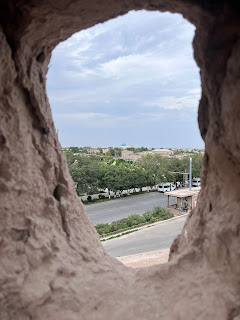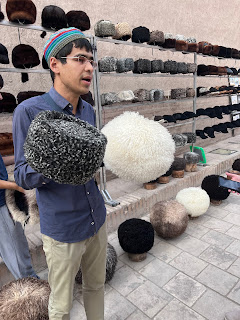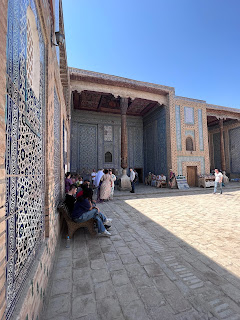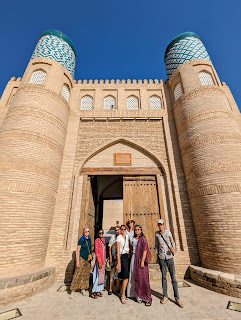July 27
We waved goodbye to Bukhara and took a long drive to Khiva. This is the region of Khorazm, one of the oldest inhabited places in the world. It was one of the satrapies of the Persian empire. Khorazm, also known as Khwarezm, is a historical region located in Central Asia, primarily encompassing parts of present-day Uzbekistan, Turkmenistan, and Kazakhstan. It has a rich history that dates back to ancient times and was a significant center of culture, trade, and learning along the Silk Road. The region's capital, Urgench, was once a major city renowned for its architectural marvels and scientific achievements. The Khorazmian Empire, led by the powerful Shahs of Khorazm, was a dominant force in the region during the 12th century. Today, the legacy of Khorazm lives on in archaeological sites and cultural landmarks, contributing to the historical and cultural identity of the countries that were part of this ancient region.
We drove across the Amu Darya River, one of the largest rivers in Central Asia. We have seen the big rivers on this trip, and they are central to the history, as water is life.
Let's talk about Khiva, this last and important city on our journey, a fitting end for this marvelous fellowship. It is renowned for its well-preserved historic architecture and rich cultural heritage. It is situated along the Silk Road and served as a crucial trading center between the 16th and 19th centuries. The city is enclosed by impressive fortress walls, creating an atmospheric old town known as Ichon-Qala. Within these walls, visitors can explore numerous ornate mosques, madrasahs, palaces, and mausoleums that showcase exquisite Islamic architecture and intricate tilework. The Itchan Kala complex, a UNESCO World Heritage Site, offers a glimpse into Khiva's past and allows tourists to immerse themselves in the city's storied history and unique charm.
There was a dark chapter in the city's history. From the 17th to the 19th centuries, Khiva was notorious for its thriving slave market. The Khiva Khanate, a powerful Central Asian state, engaged in the capture and sale of slaves, primarily obtained through raids on neighboring regions. Enslaved people were traded as commodities and subjected to brutal conditions, often enduring forced labor, abuse, and deprivation of basic rights. The trade flourished as a significant source of revenue and labor for the Khiva rulers. In the late 19th century, Russian forces eventually conquered Khiva, and the practice of slavery was officially abolished.
When we arrived, the sun was actually behind some clouds, giving us a welcome reprieve from the over 100 degree temps we had been experiencing. I took advantage (because the power was also out in the hotel) to take a walk around the gates of the old city. These have been restored. In the photo below you look out into modern Khiva where people make their lives. There are some obvious old things everywhere, but inside the walls are where we stayed and most of the things were.
Then I walked out of the walls and visited the summer palace of the khanate, which was mostly an 18th-19th century building, but the khanate existed from 1511. It ended with the takeover of Lenin and the Soviets in 1920.
The khan (king) always had a reception area, and there were sometimes different ones for different purposes. We saw this in other places, but I have not really explained it. There was a summer reception area outside, and a winter one inside. Also, there could be a separate one for visits having to do with appealing to the khan.
Photos from our walk around Khiva. This is the Minoret Kalta Minor. It is a famous turquoise tiled landmark that was supposed to originally be three times taller. is a unique and distinctive structure that stands as a testament to the city's architectural heritage. It was commissioned by the Khiva Khan Muhammad Amin Khan in the early 19th century as part of a grand plan to construct an imposing minaret. However, the minaret was never completed due to the untimely death of the khan, leaving it in an unfinished state. As a result, the minaret is notably shorter than originally intended, earning it the name "Kalta Minor," which translates to "Short Minaret." It is 28 meters tall and half that in its largest width. It is made of koshin tiles, which are adapted from Persian tiles but made locally here. Construction 1851-54
Legends for why it didn't end up taller are varied. One is that the Kahn wanted it tall enough to watch over Bukhara, which they were always in contest with. The contractor had a secret deal with both and news came to the Kahn would kill him. So the engineer left and flew away, but actually he was killed in war.
Despite its incomplete state, the Minaret Kalta Minor stands out for its remarkable design and ornamentation. It showcases a striking blue and green glazed tilework, characteristic of Central Asian Islamic architecture. The lower part of the minaret features intricate patterns and designs, while the upper section remains plain. The minaret's base is wider than the upper part, creating a tapering effect, which is common in traditional minarets.
This guy is very handsome and regal and quite well cared for compared to some sad camels I've seen. These are bactrian camels and have two humps compared to those in the Middle East that you generally see with one, the dromedary camel of the Arab world.
Sun setting in this historic city. What a wonderful evening.
July 28
We began our morning early, walking through the historic parts of the old city, Erkin our erudite guide, explaining so many interesting aspects of the city and its history and culture.
First, Khiva is a city of “sweet water” and city of wells. Nothing here is more than 250 years old because it was ransacked in the mid 18th century. The changing of the flow of water of Amu Darya river from the Caspian Sea to Aral Sea made Khiva the new capital from where it was in modern Turkistan (the name for the larger region before the Soviets split it up).
The Khiva Khanate troubled by a lot of wars and attacks.
Madrassa and turquoise tower (minaret): madrassa is the largest in Khiva.
Tw thirds of the kings of Khiva were deposed while in power.
Fortress of the king. Kuhna Ark, a third residence of the ark and the oldest one from the 18th century. Large cannons stood outside it. The king would come out each day. It was also the registan where public announcements would be made.
Inside to the right was the iwan which always faced north and was the mosque for the king. It is completely made of tile in the early 19th century. The tile maker was seen as a jin because his talents were so profound in designing the tile work. All of the tiles are numbered but not in the Indian numbers. They are in Arabic numerals.
If you look carefully you can see the numberings on the tiles. These are in Arabic writing, not numerals. It took an artist and mathematician to create entire walls of designs that would all fit together. They are stunning to behold.
The fluffy hats (shugirma) were worn from age 12. However, if you committed adultery or minted money, you could not wear the fluffy hats. The minters were also not allowed to wear beards.
We also learned something really interesting about a group of Mennonites who came to Central Asia and lived in Khiva and introduced potatoes and eggplant to Central Asia in the late 1800s. This surprised me. Also, the Mennonites were excellent woodworkers and were given many rewards. There was a lot of tolerance, and their skills and crafts were highly regarded and sought after. The congregation in Khiva was gifted with an organ by the Khanate. The families had photos of the king in their homes.
The first Khivan photographer learned from German Mennonites.
Stalin deported them when the Mennonites would not be part of the collective farms. He sent them to Tajikistan, and then they spread out.
More photos from the ark in Khiva, with a good view of the city from on top of the walls.
This is a design unique to Khiva and is used in their carpet workshops now. I love it.
Another reception area for the khan, as I wrote about above.
The oldest building surviving in Khiva is the Juma Mosque from the 10th century. A tower was built there, and then destroyed. A new tower was built in the 18th Century by private funds that had been saved daily by a minister, according to legend, while the khan was away. The khan was impressed.
The mosque was built on the remains of the Zoroastrian fire temple, which is common for where mosques were placed all over Central Asia. It has 213 columns from different periods. Only two survive since the 10th century. It is one of only two significant mosques in the world that does not have a dome over where the imam speaks. There was a series of holes around where the sound would come out around the mosque.
Islam Khoja was born in 1831 and died when only 42 years. He was like an Uleg Beg of Khiva and went to Russia to learn. He was fluent in several languages and became prime minister and protector of Khiva who brought new technologies and learning centers. He encouraged medicine and started to build the tallest tower, which was finished years after his death. He was not like by the king, and he was assassinated, though that has not been definitively proven.
The minaret named after him is the largest in Khiva, which is fitting, since he received an unjust end. The photo below is of Islam Khodja.
The Pahlavon Mahmoud (1247-1326) madrassa was a neat place we stopped at. His contributions were not really recognized until after he died, but he became like a saint. He was multi-talented and was a poet, furier, and wrestler. He was well known for wrestling during his time though and rescued an Indian king and horse from a mid mire. The king rewarded him by taking people out of captivity in Khorezum. PM was always humane and has become famous for that. His body was buried in the mausoleum created in the early nineteenth century. It is beautiful, with the largest dome in Khiva, and subsequent kings were buried there. Many visitors come to ask for blessings, and there is an imam usually there reciting prayers. There was one with a beautiful voice, citing prayers, I'm assuming from the Qur'an in Arabic. Food and bread are also left there for pilgrims asking for blessings, and when you bring some, it is thought to help your case also.
The madrassa and harem we went to at the end of our walking tour were built in the 1840s by the khan who also built the fortification walls of the city. The harem was fortified and away from the busy parts of the city. There is a well inside the courtyard to provide water in case they had to close off because of attacks. There are four cells for the official wives and then many other terraces for the concubines. The bow-tie looking tiles probably came down from Zoroastrian religion for good thoughts, good words and good deeds. It may also mean to tie the mother and father to children.
The king and the four wives each had a cell on the left. Each wife had a bathing area as well, which you can see in a photo below.
An opening to the king's area.
The bathing area for one of the wives.
A summer reception area.
Also, we saw another reception area for the king to meet visitors and a separate reception center to meet with people who had formal appeals.
Beth and I tried on and purchased the fur hats. Mine feels like a Russian lady, and I am excited to wear it in the winter.
The young man is holding stones, which it clicked, and they sounded more like tinkling bells than stones
A wedding couple came through and was congratulated by the performers.
Vina is a fantastic dancer and danced with the woman.
Is not this spectacular!























































.jpg)





































No comments:
Post a Comment